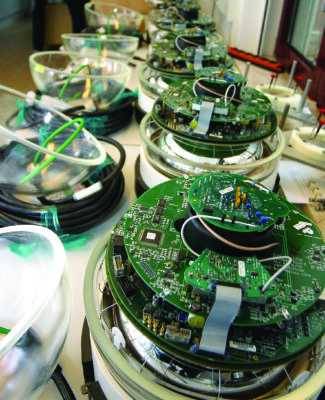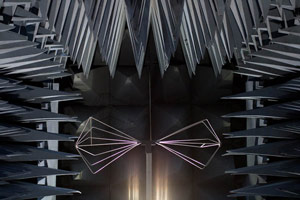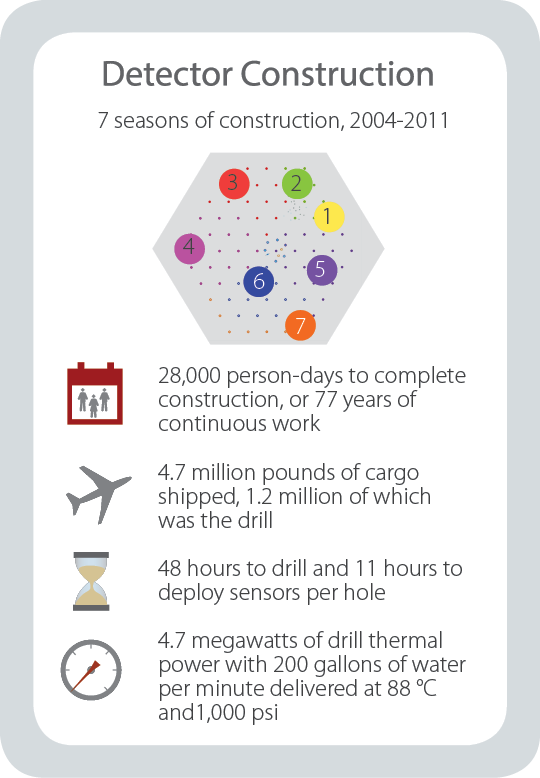Instrumentation
Modern experimental astrophysics and particle physics require complex electronic and mechanical equipment, often located in remote places on Earth. Sensing and processing signals from particle interactions usually depend on cutting-edge technologies.
WIPAC closely collaborates with institutions worldwide to meet the challenges of innovative detector design, fabrication, project management, and construction. Development of instrumentation and facilities for large-scale experimental astrophysics programs typically calls for a multidisciplinary approach across the fields of particle physics, engineering, and computer science.
WIPAC research and development benefits from the expertise that was forged through the successful design, construction, and operation of the IceCube Neutrino Observatory and its predecessor, AMANDA. We also play a leading role in the construction and operation of the ARA detector and collaborate on DM-Ice, both at the South Pole as well. And we are working on instrumentation R&D for the next-generation IceCube and for CTAO and CHIPS, two observatories currently under construction.
Our team has designed robust and reliable systems—light detection at the photon level and low-noise sensors for radio—that also reduce power needs. We have developed data-taking systems that achieved nanosecond time synchronization over kilometer-scale distances. The world-class R&D facilities available at UW–Madison allow us to support experiments all around the world that are pushing the frontiers of the unknown universe.
Core Competencies
- Cold testing
- Comprehensive analog and digital design
- Data acquisition firmware and software
- Photon detection
- Radiofrequency electronics design
- Remote, extreme environments
- Scientific computing
- Subnanosecond time synchronization
R&D Engineering
WIPAC engineers have been involved in the design and construction of light sensors for both IceCube and AMANDA. These digital optical modules, or DOMs, house a PMT and a computer encased in half-inch-thick glass and record the light

produced by the interaction of neutrinos and other high-energy particles with the ice. The IceCube sensors were deployed in the ice, where they remain frozen in place, forever inaccessible and exposed to extremely high pressures. The requirements for DOMs impose demanding specifications that surpass even those of robust satellite instruments. And we are now facing a new challenge: improving the DOM design to increase its sensitivity and reduce its power consumption in preparation for building a cost-efficient and ten-times-larger detector.
Our team has also developed radio antennas for ARA, which detects the emission of radio waves produced by the interaction of neutrinos with Antarctic ice. These antennas have a wide frequency response and are sensitive to both vertically and horizontally polarized signals.
WIPAC physicists, engineers, and IT specialists helped to design and develop the data acquisition (DAQ) system of IceCube, a complex and decentralized architecture of sensors, electronics, and computers. Individual DOMs detect, digitize, and time-stamp the signals from high-energy particles. Subsystems of paired DOMs are then connected to the central DAQ by a single twisted pair of copper wire, also used for power distribution. Time calibration, with a resolution of two nanoseconds, is maintained throughout the detector by precisely timed analog signals, synchronized to a central GPS-disciplined clock.
Several DAQ elements are frozen in the depths of Antarctica. Therefore, reliability and programmability considerations were crucial drivers of the engineering process. IceCube’s DAQ has always performed extremely well, as has the rest of the IceCube detector. Of the 5,484 deployed DOMs, 98.4% are still taking data. In addition, the software systems also currently provide high weekly uptimes, above 99.8%.
Design and Test Facilities
The PMTs used in IceCube as well as in the HAWC Observatory in Mexico are extremely sensitive devices. Reconstruction of the energy and direction of detected particles in these detectors, and thus the scientific outcomes they enable,

strongly depends on our knowledge of the PMT response to light. In a similar way, the sensitivity of the ARA antennas determines its discovery potential.
WIPAC facilities at UW–Madison include an electronics design lab and a PMT testing lab, where PMT sensitivity and variations in its angular response are studied. A second testing facility, located at the Physical Sciences Lab (PSL), is equipped with three walk-in dark freezers that allow monitoring PMT response, over time and from changes in temperature, as well as the response of NaI crystals of the DM-Ice detector.
Finally, another facility available to WIPAC is an anechoic chamber designed and built to test the antennas and other hardware of the ARA detector. This 10 x 5 x 5 meter chamber is useful for evaluating radio frequency instrumentation in a low-noise environment. It allows the simulation of large spaces by eliminating reflections of electromagnetic waves within its interior.
Production and Construction

As the lead institution of the IceCube Neutrino Observatory, WIPAC managed the production of sensors, cables, and other equipment as well as the construction operation at the South Pole. In collaboration with PSL, over one third of IceCube’s DOMs were integrated and tested in Madison.
But the engineering feat that made the construction of the first cubic-kilometer neutrino detector possible was the design of the enhanced hot water drill that reduced the time and fuel it took for each 2.5-km long borehole. This drill, with a modular head that could withstand external pressure of 5,000 pounds per square inch, optimized hole shape with almost perfect vertical alignment. A full borehole was drilled in about 1.5 days, and safety-related issues were few in number.
This team, in collaboration with WIPAC researchers, allowed us to design, build, and deploy the dark matter detector DM-Ice in only nine months. The current construction of ARA and the future deployment of an upgrade to the IceCube detector will benefit from the skills and expertise gained from IceCube.
Operations
WIPAC hosts a diverse team of professionals responsible for the maintenance and operation of IceCube and ARA, who work in collaboration with researchers from international institutions of both collaborations.
Operation of the IceCube detector, which collects data 24 hours a day, 365 days a year, is performed by over 40 dedicated staff, 80% of which are based at WIPAC. Part of this team also assists with operation of the ARA detector.
Duties of this team include maintenance and upgrades to the DAQ and data management systems, managing data taking and calibration runs, and processing of data to provide science-ready samples. This work, in close collaboration with the WIPAC IT team, includes logistics support at the South Pole and a continuous R&D program to improve the detector uptime and quality of the data provided to the IceCube and ARA collaborations.
